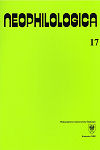Occhio all'italiana – cioè il ruolo dell'occhio nell'immagine linguistica del mondo italiano
“Occhio” (eye) à la Italian – the role of “occhio” in the linguistic image of Italians' world
Author(s): Aleksandra KoszSubject(s): Language and Literature Studies
Published by: Wydawnictwo Uniwersytetu Śląskiego
Keywords: cognitive grammar; imagery; categorization; conceptualization; concept; profile
Summary/Abstract: This paper investigates a cognitive study of the “occhio” (eye) concept in Italian. It contains an explanation of the chosen concept and explores its meaning and symbols not only in a language, but also in culture and religion. It comments on general concepts of cognitive linguistics like categorization and conceptualization in language. This research primarily utilizes the theory of Cognitive Grammar proposed by R.W. Langacker and also incorporates the Polish approach with “JOS, The Linguistic Image of the World” introduced by J. Bartmiński. The project focuses on describing the ways people perceive and define the world and reality and how they identify things and events. There are six distinguished “occhio”-profiles: structural, functional, animistic, intellectual, communicative and sentimental. These profiles reflect what the expressions containing the “occhio” (eye) or ways of speaking actually communicate, and what these utterances mean. In the structural profile the expressions use the “occhio” (eye) form and shape to describe objects and phenomena. The functional profile utilizes the phisiological functions of eyes: sight ability, the capacity to see and the state of sleeping (or being awake). Living beings' characteristics, such as movement and feelings can be found in the animistic profile of the “occhio” (eye). The intellectual profile shows the ability to understand, discover, judge, measure, and to estimate things. The most specific profile is the communicative profile. This profile can be connected to the intellectual one, in that it involves the capacity to speak by using the eyes, to read, to transfer some information without words. Finally, the sentimental profile includes all the locutions that somehow describe feelings or emotions. This analysis shows the different ways of world perception demonstrated in the locutions containing the “occhio” (eye) where the meaning depends on the speaker's choice and intention.
Journal: Neophilologica
- Issue Year: 2005
- Issue No: 17
- Page Range: 177-186
- Page Count: 10
- Language: Italian

